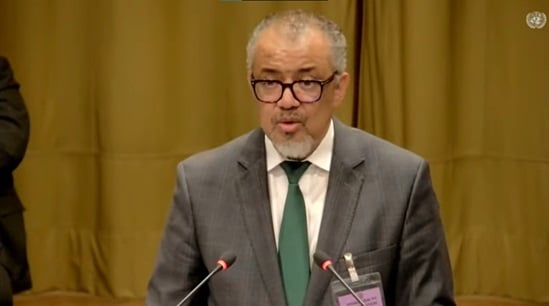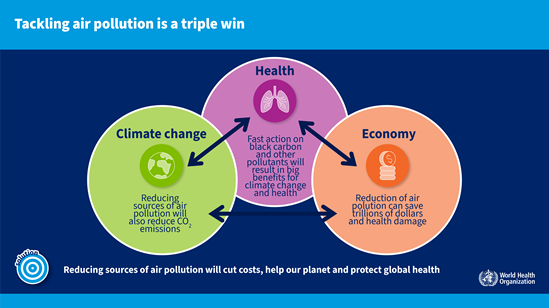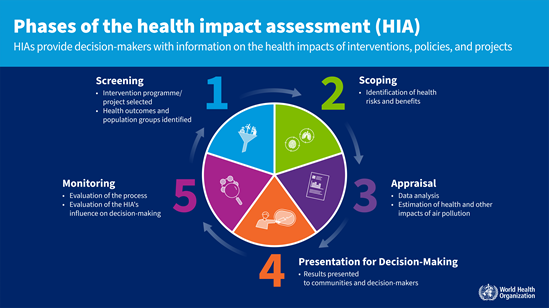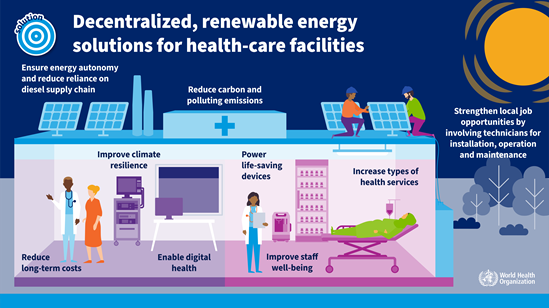Environmental health
Good health depends on clean air, a stable climate, a preserved natural environment, as well as access to adequate water, sanitation and hygiene. It also requires protection from harmful radiation, unsafe chemical management and unhealthy working conditions. A healthy environment could prevent nearly a quarter of the global disease burden.
The ongoing environmental crisis is profoundly affecting health as climate change intensifies, biodiversity declines and pollution becomes ubiquitous. The health impacts of poor environmental conditions occur not only directly but also indirectly, through effects on food production, migration, economic instability and social inequalities.
Urgent action is needed to transform how we live, work, produce, consume and govern. Strengthening primary prevention is essential, given the substantial reduction in disease burden it can offer, as well as the potential savings in healthcare costs and resources. Cross-sectoral collaboration is crucial in addressing the environmental determinants of health, including the health, energy, industry, agriculture and transport sectors. Integrating actions across these sectors often leads to significant co-benefits and cost reductions.
In 2016, 13.7 million of deaths, representing 24% of global fatalities, were attributed to modifiable environmental risks. This means nearly one in four global deaths are linked to environmental conditions.
Almost all diseases are influenced by unhealthy environments, with noncommunicable diseases (NCDs) – including heart disease, chronic respiratory diseases and cancers – being the most affected. Air pollution alone is responsible for millions of these deaths each year. Infectious diseases are also significantly impacted, with pathogens transmitted through unsafe water, sanitation and hygiene, and zoonoses rising due to ecosystem disruption. Additionally, antimicrobial resistance poses a growing threat, especially when wastewater and solid waste are not properly managed.
Climate change is exacerbating health risks by increasing the frequency and severity of extreme weather events, including deadly heatwaves. The shifting distribution of climate-sensitive disease vectors is creating new patterns of infectious diseases. Climate change also affects food production and migration, further compounding health threats. Unsafe working conditions contribute to risks across all major disease categories.
However, effective solutions exist to prevent disease and mitigate the potential burden on health systems. These solutions could significantly reduce the associated costs, which are increasingly becoming a pressing issue in many countries.
WHO’s efforts to advance the global agenda for creating healthier environments for healthier people include:
- providing leadership on key transitions: We guide critical transitions, such as those in energy and transportation, which are essential for mitigating environmental health risks. We also work to stimulate good governance practices that integrate health and environmental considerations across relevant sectors;
- promoting knowledge generation and dissemination: We facilitate the generation and sharing of evidence-based knowledge, establishing norms and guidelines that drive effective solutions. We steer research, monitor health risks, and assess the effectiveness of implemented solutions. This ongoing effort is crucial for identifying emerging threats and adapting strategies to mitigate their impact on public health;
- supporting capacity building and scaling action: We assist countries in strengthening their ability to address environmental health challenges by building local capacity and supporting scalable mechanisms for action. By fostering collaboration across sectors, we help countries to implement healthy and sustainable policies and programs that reduce risks and promote healthier communities; and
- building capacity for emergency preparedness and response: We work to strengthen emergency preparedness and response systems in case of environment-related incidents, such as natural disasters, pollution events, and outbreaks of diseases linked to environmental changes.














